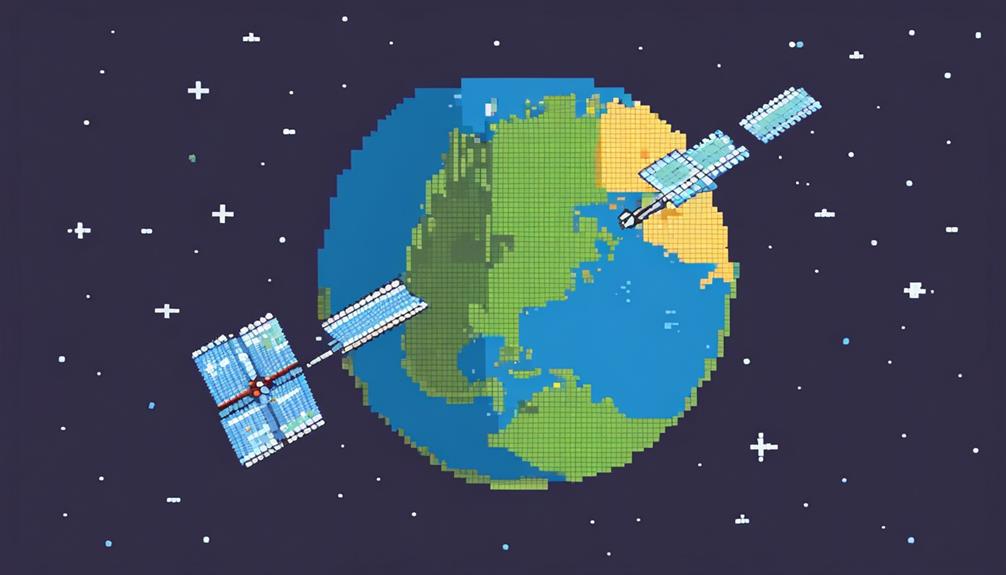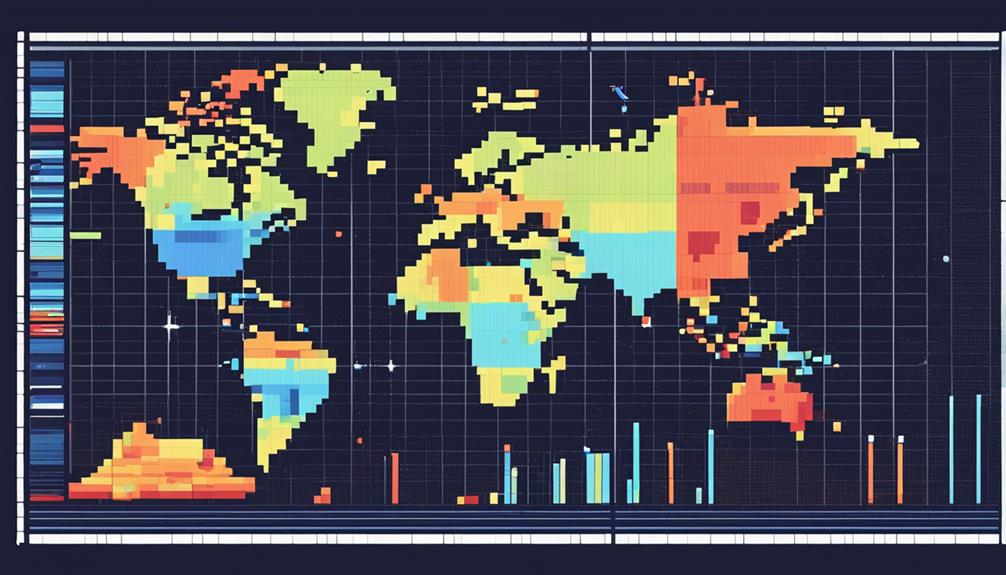Satellites have long been utilized as critical tools in monitoring the ozone layer, offering invaluable insights into its dynamics and trends. However, amidst the wealth of data they provide, myths and misconceptions have also arisen regarding their impact on ozone depletion and recovery. By examining the intersection of satellites and the ozone layer with a discerning eye, we can separate fact from fiction, shedding light on the true role these technological marvels play in safeguarding our planet's ozone shield. Let's explore the nuanced relationship between satellites and the ozone layer to uncover the realities that lie beneath the surface.
Key Takeaways
- Satellites do not directly cause ozone depletion.
- Impact of satellite mega-constellations on ozone is minimal.
- Ozone hole formation is not due to satellites in Low Earth Orbit.
- The Montreal Protocol is crucial for ozone layer recovery, not satellites.
Impact of Satellite Launches on Ozone

The proliferation of satellite launches, particularly those associated with megaconstellation projects like Starlink, poses a significant threat to the ozone layer due to the chemical reactions and emissions generated during deployment into Low Earth Orbit (LEO). Aluminum deterioration from megaconstellation satellites can chemically react with ozone, forming aluminum oxide, which has the potential to deplete the protective ozone layer. Additionally, rocket launches that are essential for deploying satellites into LEO contribute to ozone damage through emissions of various gases and particles.
Moreover, the drifting particulates from satellites into the stratosphere can also react with ozone molecules, leading to potential ozone losses. With approximately 5,000 active and defunct satellites already present in LEO and plans for launching over 40,000 Starlink satellites in the near future, concerns are escalating about the cumulative impact on the ozone layer. The sheer volume of satellites, especially from megaconstellations, could inadvertently trigger uncontrolled geoengineering experiments with unforeseen environmental consequences, further exacerbating the ozone depletion issue.
Common Myths About Satellites and Ozone
Common misconceptions surrounding the interaction between satellites and the ozone layer often lead to unfounded concerns and misinterpretations of their actual impact on atmospheric dynamics. Here are some common myths debunked:
| Myth | Reality |
|---|---|
| Satellites directly cause ozone depletion by emitting harmful substances into the atmosphere. | Satellites do not release ozone-depleting substances; their impact on the ozone layer is indirect. |
| Satellite mega-constellations like Starlink have a significant impact on the ozone layer. | While satellites can contribute to space debris concerns, their effect on ozone is minimal compared to other factors. |
| Satellites contribute to the ozone hole formation through their presence in Low Earth Orbit (LEO). | The ozone hole is primarily influenced by human-made chemicals like chlorofluorocarbons, not satellite activities. |
| Satellite activities are the primary reason behind the slow recovery of the ozone layer. | The Montreal Protocol has been instrumental in ozone layer recovery by phasing out ozone-depleting substances. |
Satellites are crucial for ozone monitoring, providing valuable data to track ozone levels and understand atmospheric changes. While harmful effects of ultraviolet radiation on the ozone layer are well-documented, satellites themselves are not direct contributors to ozone depletion. Recognizing these myths helps to clarify the actual role satellites play in atmospheric dynamics and underscores the importance of accurate information in environmental discussions.
How Satellites Actually Affect Ozone

Analyzing the interaction between satellites and the ozone layer reveals significant concerns regarding potential ozone depletion risks associated with the presence and activities of satellites in Earth's orbit. Satellites play a role in affecting the ozone layer through various mechanisms:
- Aluminum Oxide Formation: Aluminum deterioration in megaconstellation satellites, such as SpaceX's Starlink, poses a risk to the ozone layer as it can potentially react with ozone to form aluminum oxide, a compound that can impact ozone levels.
- Rocket Launch Emissions: Rocket launches to deploy satellites into Low Earth Orbit (LEO) contribute to ozone damage through emissions and the release of particulates into the atmosphere, potentially affecting ozone concentrations.
- Chemical Interaction in the Stratosphere: Satellites drifting particulates into the stratosphere can chemically interact with ozone, potentially leading to ozone depletion, especially in regions where ozone holes are a concern.
- Albedo Effects: The presence of thousands of active and defunct satellites in LEO, coupled with future plans for extensive satellite constellations, raises concerns. Aluminum oxide from satellites can scatter more light than glass, impacting Earth's albedo and potentially affecting the ozone layer's dynamics.
Monitoring the ozone layer is crucial to understand how satellites, through their activities and materials, may contribute to ozone depletion and exacerbate the harmful effects of ultraviolet radiation on Earth's environment.
Debunking Satellite Ozone Layer Myths
Contrary to common misconceptions, satellites themselves do not directly deplete the ozone layer. Instead, their materials and activities have the potential for indirect impacts on ozone chemistry. Understanding the accuracy of satellite data in ozone layer monitoring will help clarify misconceptions about the role of satellites in ozone depletion.
Satellite Data Accuracy
In the realm of ozone monitoring, the accuracy of satellite data is meticulously verified through rigorous ground-based measurements and validation processes. Satellite observations play a crucial role in assessing stratospheric ozone levels post the Montreal Protocol. To ensure precise data collection, ozone monitoring satellites are equipped with sophisticated instruments such as spectrometers and sensors. Advanced algorithms and calibration techniques further enhance the accuracy of satellite-derived ozone measurements. By comparing satellite data with historical ozone records, scientists can evaluate long-term trends and changes in the ozone layer. Mission-specific testing and calibration procedures are implemented to guarantee the reliability and accuracy of the collected data.
- Satellite observations verify ozone accuracy.
- Instruments like spectrometers aid in data collection.
- Algorithms enhance satellite-derived measurements.
- Comparison with historical records evaluates long-term trends.
Ozone Layer Monitoring
Utilizing advanced satellite technologies, the monitoring of the ozone layer aims to debunk prevalent myths surrounding satellite-derived ozone data. Satellite monitoring plays a crucial role in tracking ozone layer depletion and recovery trends, providing valuable insights into the impact of human activities on the ozone layer. Technologies like SCIAMACHY and Tropomi offer detailed data on ozone distribution and changes, enabling scientists to identify anomalies such as the Antarctic ozone hole. These observations are essential for assessing the effectiveness of environmental protection measures like the Montreal Protocol in combating climate change effects on the ozone layer. Continuous satellite monitoring is vital for understanding ozone layer dynamics and ensuring informed decision-making to protect this critical component of Earth's atmosphere.
Common Misconceptions Clarified
Amidst the advancements in satellite technology for ozone layer monitoring, it is imperative to address and debunk prevalent misconceptions surrounding the role of satellites in ozone layer protection and depletion. Here are some key clarifications:
- Satellites do not contribute to ozone layer depletion; they aid in monitoring ozone levels.
- Aluminum deterioration in satellites like SpaceX's Starlink poses a risk to the ozone layer due to chemical reactions with ozone.
- Rocket launches for satellite deployment can impact the ozone layer by releasing particulates that may react with ozone.
- The increasing number of satellites in Low Earth Orbit raises concerns about potential ozone damage from the space industry and mega-constellations like Starlink.
The Role of Satellites in Ozone Monitoring
Satellites play a crucial role in ozone monitoring by providing accurate data on ozone levels, allowing scientists to analyze trends and fluctuations in the ozone layer. Advancements in monitoring technologies have enhanced the precision and detail of satellite observations, enabling a comprehensive understanding of ozone dynamics. These advancements pave the way for future missions to continue monitoring the ozone layer and contribute valuable data for atmospheric research.
Satellite Data Accuracy
Effective monitoring of ozone levels and detecting changes in the ozone layer heavily relies on the precision and accuracy of satellite data.
Key Points:
- Reliable Data: Satellites provide accurate information crucial for monitoring ozone levels.
- Tracking Trends: Satellite observations enable precise tracking of changes in the ozone layer over time.
- Vertical Distribution: Data from satellites like Sentinel-5P helps understand the vertical distribution of ozone.
- Informed Decisions: Advanced satellite technologies offer detailed insights into factors affecting ozone depletion, aiding in protecting the ozone layer and life on Earth.
Ozone Layer Trends
The utilization of satellite technology has been integral in monitoring and analyzing trends in the ozone layer over the past few decades. Satellites, particularly European ones like MetOp, ERS-2, and Envisat, have played a crucial role in providing valuable data on ozone levels. Projections indicate a decreasing Antarctic ozone hole with ongoing monitoring efforts and global collaboration. Future satellite missions such as Copernicus Sentinel 4 and 5 are poised to further enhance capabilities in monitoring the ozone layer. The European Space Agency's Climate Change Initiative is actively working towards harmonizing ozone climate data records to facilitate a more comprehensive understanding of ozone layer trends. Through satellite monitoring, significant strides have been made in comprehending the dynamics of the ozone layer and its crucial role in the Earth's atmosphere.
Monitoring Technology Advancements
With advancements in monitoring technology, particularly through satellite observations, the understanding of ozone levels and their vertical distribution has significantly improved over the years.
Key Technological Advancements:
- Satellites like SCIAMACHY and GOME-2 pivotal in ozone monitoring since 1979.
- Tropomi technology providing detailed ozone profile measurements for enhanced accuracy.
- Future missions such as Sentinel-4 and -5 crucial for continuous ozone monitoring.
- Limb observations from satellites offer detailed insights into the vertical structure of the atmosphere, aiding comprehensive ozone monitoring efforts.
These advancements play a vital role in monitoring the ozone layer and understanding its impact on Earth's climate, showcasing the importance of satellite technology in environmental research and protection.
Misconceptions About Satellites and Ozone
Amidst discussions surrounding satellites and their impact on the Earth's ozone layer, misconceptions often arise regarding their direct role in ozone depletion. Contrary to some beliefs, satellites themselves do not release substances that deplete the ozone layer. Instead, the primary concern lies in the potential effects of space debris and chemical reactions that may occur from satellite materials interacting with ozone molecules.
One common misconception is that satellites directly contribute to ozone depletion. While satellites can influence the environment through space traffic and debris, their impact on the ozone layer is mainly indirect. The concern stems from the possibility of aluminum oxide formation resulting from interactions between satellite materials and ozone molecules.
It is crucial to recognize that the direct role of satellites in ozone depletion is minimal compared to human activities such as emissions of ozone-depleting substances like chlorofluorocarbons (CFCs). Understanding the nuanced relationship between satellites and the ozone layer helps dispel misconceptions and underscores the significance of responsible practices in space activities. By clarifying these misconceptions, we can better appreciate the actual risks and benefits associated with satellite technology and its implications for the ozone layer.
Facts About Satellite Data and Ozone

Utilizing advanced remote sensing technology, satellites play a pivotal role in providing essential data on ozone levels and monitoring the ozone hole. Here are some key facts about satellite data and ozone:
- Satellites provide crucial data on ozone levels and the ozone hole through remote sensing technology. This data is essential for understanding the state of the ozone layer and tracking any changes over time.
- Satellite observations help track changes in ozone concentrations and monitor the recovery of the ozone layer. By continuously monitoring ozone levels, satellites contribute to our understanding of ozone dynamics and trends.
- Specific satellite missions like Sentinel-5P contribute essential ozone monitoring data for research and analysis. These missions are designed to focus on gathering detailed information about ozone distribution and variability.
- Satellite data is integrated with numerical models to enhance ozone monitoring accuracy and forecasting capabilities. By combining satellite data with advanced modeling techniques, scientists can make more precise predictions about ozone trends and behavior.
Reality Check: Satellites and Ozone Health
What critical role do satellites play in assessing the health of the ozone layer and monitoring its dynamics? Satellites are essential tools for monitoring the ozone layer's health and dynamics, providing vital data for understanding its current state and tracking changes over time. By utilizing advanced technology, satellites offer valuable insights into the ozone layer's composition, distribution, and depletion trends. These observations are crucial for assessing the impact of human activities on the ozone layer and evaluating the effectiveness of international efforts to protect it.
| Role of Satellites in Ozone Monitoring | Benefits |
|---|---|
| Tracking ozone levels and dynamics | Provides real-time data on ozone depletion |
| Understanding human impact on the ozone layer | Assesses recovery progress and depletion trends |
| Vertical distribution of ozone insights | Enhances understanding of ozone layer health |
| Advanced technologies like Sentinel-5P | Offers detailed measurements of ozone concentrations |
| Contributing to global ozone protection efforts | Supports climate and environmental monitoring |
Satellite data not only aids in safeguarding the ozone layer but also plays a critical role in climate and environmental monitoring. The continuous monitoring facilitated by satellites is fundamental in ensuring the long-term health and sustainability of the ozone layer, essential for maintaining a stable climate and protecting life on Earth.
Frequently Asked Questions
Do Satellites Affect the Ozone Layer?
Satellite technology, a crucial component of modern communication and observation systems, does have an environmental impact on the ozone layer. The deployment and operation of satellites contribute to atmospheric changes that can affect ozone levels. It is essential to consider the implications of satellite activities on atmospheric protection and to develop strategies that minimize any potential harm to the ozone layer.
What Is a Misconception About the Ozone Layer Depletion?
A prevalent misconception regarding ozone layer depletion is the belief that it has been fully recovered. This false narrative undermines the ongoing environmental impact of ozone layer depletion, which continues to pose serious threats to human health and the ecosystem. While international efforts and monitoring have made progress, the need for continued vigilance and research remains crucial to effectively address the current and future challenges associated with ozone layer depletion.
How Do Satellites Monitor the Ozone Layer?
Satellites play a critical role in monitoring the ozone layer through remote sensing techniques. They measure ozone concentrations by observing the atmospheric composition at different altitudes. This data aids in atmospheric monitoring, providing insights into ozone distribution and potential depletion. Utilizing advanced technologies, satellites offer detailed information on ozone levels, contributing to a comprehensive understanding of the ozone layer's dynamics and trends over time.
Is the Ozone Actually a Hole in the Sky?
The concept of the ozone layer as a "hole in the sky" is a common misconception that has been debunked by scientific understanding. The term "ozone hole" actually refers to a localized depletion of ozone in the stratosphere, particularly over Antarctica. This phenomenon, while not a literal hole, signifies a significant thinning of the protective ozone layer rather than an actual void or gap in the sky.
